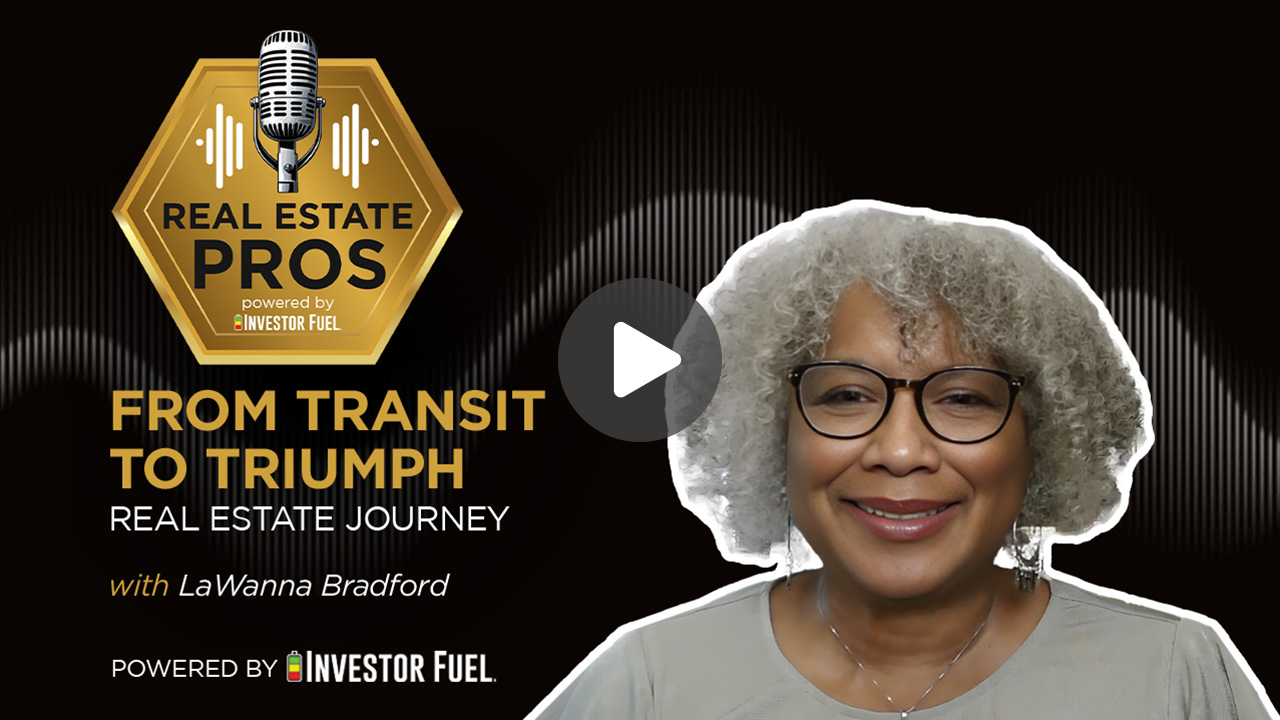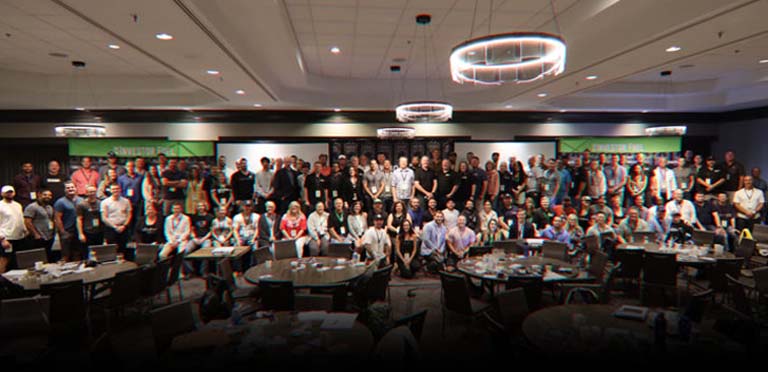
Show Summary
In this conversation, LaWanna Bradford, COO of the Bradford Group, shares her journey from the mass transit industry to the world of commercial real estate. She discusses the impact of the 2008 mortgage crisis on her career, the transition to commercial lending, and the various types of commercial properties she has worked with. LaWanna emphasizes the importance of understanding risk management, evaluating deals, and offers advice for those looking to enter the commercial real estate space.
Resources and Links from this show:
Listen to the Audio Version of this Episode
Investor Fuel Show Transcript:
Dylan Silver (00:01.516)
Hey folks, welcome back to the show. I’m your host, Dylan Silver. And today on the show, I have the COO of the Bradford Group, herself based out of Atlanta, Georgia, Lawana Bradford. Lawana, welcome to the show.
LaWanna Braadford (00:19.995)
Thanks Dylan. How’s it going?
Dylan Silver (00:21.834)
It’s going great. I actually think there might be something in the airwaves today. We rarely have this, but we’ve had two people on the show from Atlanta, Georgia. said, man, there must be something in Atlanta out there.
LaWanna Braadford (00:35.867)
We just want to make our connections in the Texas area.
Dylan Silver (00:38.86)
That’s gotta be the thing. That’s gotta be the thing. Well, welcome to the show. I always like to start off at the top and you’re definitely involved in a niche space with with lending and investments and in commercial. But how did you get into the real estate space?
LaWanna Braadford (00:54.727)
That’s a very interesting question. So I was an executive for mass transit.
here in Atlanta and I just decided, you know, I’m tired and I want to take a break. And so I decided to take a respite from corporate and my brother was actually the one that had founded the Bradford Group, which at the time was a residential mortgage provider. And I came on board just to help him with compliance issues. He had 13 loan officers at the time. And Dylan, I got bitten by the bug and I thought, wow, this is an opportunity for me to learn a new industry and see
Dylan Silver (01:27.714)
Ha ha ha ha!
LaWanna Braadford (01:31.791)
about creating another revenue stream and we were doing well until you know the mortgage crisis hit in 2007-2008. He was a recent father of twins and he said, Luana I’m not going to be able to stay here. So he bailed, I stayed, the rest is history. We’re celebrating 19 years but this time on the commercial front.
Dylan Silver (01:39.106)
Thanks
Dylan Silver (01:56.108)
So a lot to unpack there, but the Bradfords stayed winning in the Bradford group. One Bradford went and another Bradford, you got subbed in, you got subbed in. I think, know, what’s interesting about, you mentioned, you know, mortgage crisis, 2008 timeframe. That was really a timeframe where…
LaWanna Braadford (02:07.42)
Yes.
Dylan Silver (02:17.238)
a lot of people who were really doing really, really, really well beforehand, because frankly, I mean, maybe this is an unpopular thing to say, but they were just giving out mortgages, right? So they were just, you have a pulse, here’s a mortgage.
LaWanna Braadford (02:28.039)
of them. Exactly.
Dylan Silver (02:30.752)
And so there was a lot of people who were making money hand over fist and then regulations come down, Dodd-Frank comes down. Now it feels like I’m 31 years old. It feels like people that are young people feel like how do we get a house? We need now a blood sample to get a home. And so things changed and you saw an opportunity in commercial. So did you know that this was gonna be something that you were potentially gonna pivot to down the line and then the financial crisis accelerated?
that or were you having to kind of pivot on the fly?
LaWanna Braadford (03:04.547)
No, we literally pivoted on the fly because we saw obviously banks are closing. We saw people to the left and right of us as far as mortgage providers closing. And I’m thinking how do we survive? What area is not being hit as heavily? And that was the commercial side.
Dylan Silver (03:22.476)
So I want to get granular here and talk about those relationships that you formed. Because I know, as someone who just went through real estate school, the investment side of things and the…
residential, you know, family who’s looking for their starter home or moving relocating, cut to totally different worlds. And if I’m talking about, you know, ARVs and rehab budgets with residential real estate agent, they might not know is the lending side is it like two different worlds with commercial and investments in residential as well?
LaWanna Braadford (03:54.403)
Exactly, so on the residential side, I’m looking at the viability of that borrower, their ability to pay back the loan. On the commercial side, I’m looking at the property and its ability to service the loan.
Dylan Silver (04:09.198)
So it was a big pivot for you. What were the steps in that like? Were you having to kind of go out there and make the connections with the lending institutions or with private lenders? Were there private lenders out there? Was there kind of this feeling that there’s like blood in the water and a lot of concern or was it the opposite? There’s blood in the water and we need to buy a bunch of property because now is the best time to buy.
LaWanna Braadford (04:34.535)
A little of both. think what I wanted to do was find that blue ocean where a lot of people were not swimming. And so the first thing I did was look at my current lending base, which ones had a commercial side of the house to find out how do we get over there and becoming a licensed broker under the commercial side, making sure I had the training because again, it’s a totally different world. But then finding individuals who have been doing commercial
Dylan Silver (05:00.29)
Yeah.
LaWanna Braadford (05:04.489)
for a while and asking, just coming straight out, introducing myself, saying this is where I am, I’m trying to stay afloat, can you mentor, guide me in this space?
Dylan Silver (05:15.052)
And so you took it from there to then scaling out of that. Let’s talk about the first deals. What were the first deals like? How did you find the property? How did you find the ultimate? I’m not even sure the terminology in this space, the buyer of the deal, you know?
LaWanna Braadford (05:29.895)
Sure.
Well, what I did, I think it helps because in the corporate side, I was a strategist. So I started looking at the environment that we were in and like, where could possible partner relationships exist? And I thought, banks, let’s go to your major lenders. And so I’m knocking on the door of at the time, SunTrust, which was still there, Chase Bank, Bank of America. And I said, do you offer commercial loans? And they said, yes. And I said, well, what’s the criteria?
Dylan Silver (05:45.486)
Thank you.
LaWanna Braadford (06:00.777)
told me and I said, what do you do for those individuals that don’t meet this particular criteria but still need a lending source? And that’s when I found out that they had partner relations. So my first actual partners were with larger banks who couldn’t service because of their guidelines, couldn’t service their clients. So rather than turning them away, they passed them on to us.
Dylan Silver (06:24.032)
So let’s talk, let’s get granular here and talk about the deal. Don’t give away all the gold, LaWanna, but maybe give away some of it. So you made these partnerships with the banks, but then you need the properties themselves, right? So are people coming to you and saying, hey, I wanna take a look at this? Are you going out when you’re effectively bootstrapping? Are you finding these properties yourself? How are you finding the physical properties?
LaWanna Braadford (06:50.66)
No, the individuals were coming to me. So we’ve started off with individuals with daycare centers.
Why? Because we just noticed there are a lot of daycare centers in Atlanta and it seemed to be low hanging fruit. We literally went door to door making, you know, old fashioned connections and finding out how could they stay afloat given where the marketplace was. And so looking at what they could do to harvest or refinance their existing property to create sustainability. So that was the first thing we did. We looked at individuals who
Dylan Silver (07:01.891)
Yeah.
LaWanna Braadford (07:27.465)
currently owned commercial real estate. We also went to two churches. And in fact, during the pandemic, we went back to churches because we’re like, everybody’s shut in. How are you gonna survive? How are you gonna pay this mortgage over your head? Perhaps we can restructure this debt for you.
Dylan Silver (07:33.326)
Mmm.
Dylan Silver (07:48.206)
So restructuring, refinancing, this was a niche that you dove into. Getting through 2008, 2009, through to the latter years, things are starting to come around. What did the business scale to and what were the deals that you were involved in? Did they grow from there and were there other verticals that you were looking at?
LaWanna Braadford (08:10.497)
Sure, we started off as I said, we did churches, did daycare centers, a wonderful unit. Your fix and flips were really big for us. And then we started tapping into warehouses, strip malls.
Dylan Silver (08:18.478)
Yeah.
LaWanna Braadford (08:27.735)
And we found that, especially on the warehouse side, there is a huge demand. As we mentioned earlier, Dylan, there is a large, very growing, expanding rental market. So many of these individuals who have lost their homes or perhaps are at a point where they’re downsizing, where are they gonna put all their stuff? Because Americans love their stuff, right?
Dylan Silver (08:43.512)
Huge.
Dylan Silver (08:54.23)
storage facilities.
LaWanna Braadford (08:55.909)
Yeah, so storage facilities we found out. Hey, that’s, that was a cash cow.
Dylan Silver (09:01.27)
Now you mentioned a couple different churches. You mentioned daycare centers. You mentioned strip malls, storage facilities. these are all, you know, they have their own models, right? And so being knowledgeable in all of these is
is challenging because it’s not like a single family home where you might have a different size, you might have a different location. But the cash flow model of a daycare center is drastically different. The liability of a daycare center is drastically different than a storage facility. I mean, as you’re probably aware, the storage facility, sometimes people just leave their items in the storage facilities and then they get auctioned off.
LaWanna Braadford (09:21.679)
Exactly.
LaWanna Braadford (09:35.931)
Yes.
Dylan Silver (09:42.296)
you’re not leaving your items at the daycare sign right? Because the item is the kid, right? So it’s a totally different area. As you were moving into these different areas, what was the process like of getting schooled up in it? Is it a lot of learning on the fly? Is it you’re having mentorship in these areas? Or are you kind of doing some legwork ahead of time in preparation for coming across these deals?
LaWanna Braadford (09:44.999)
Exactly.
LaWanna Braadford (10:09.607)
It’s both. It’s definitely having mentorship after you decide which lanes you want to operate in. Some individuals who are coming into the commercial space, they find out, this is really, really big and diverse, and they’re trying to do everything. I’m like, no, I’m not trying to do everything. I wanted to, again, start off small. So again, those one to four units, then the daycare centers, then the churches. And a plate offering is very different than what you’re collecting from a daycare center as far as state subsidized.
care. So there’s a lot of information there. And then we started getting into commercial development, but we capped it at 20 million and below. Because I’m like, the other stuff is just way complicated. And so we found where our sweet spot was.
Dylan Silver (10:39.521)
Yeah.
Dylan Silver (10:58.85)
So commercial development, when I’m thinking about commercial development, a lot of things come into play. I’ve heard medical, but not necessarily hospitals, but I’ve also seen you could do residential commercial on a smaller scale. What was the businesses that were taking out these loans in the commercial space?
LaWanna Braadford (11:21.639)
they were apartment complex and subdivisions.
Dylan Silver (11:27.34)
And so I’ve talked with lots of people who are developers who build these types of deals and there’s a lot of risk and a lot of leverage on both sides, right? So you have to get, if it’s apartments, you have to get everything rented out. If it’s subdivisions, you have to get everything sold. And so…
As I’ve seen being a realtor, they’re selling these before they get built and then when everything’s built, they gotta sell them. As a lender and as a broker in this space, when you’re looking at these deals, you’re looking at the deal itself, what are the things that you’re looking out for? Say, hey, this is a good deal or hey, I really can’t be involved with this.
LaWanna Braadford (12:08.263)
Sure.
Well, the first thing is the individual or businesses experience in that area. So if you say, I’m developing a subdivision. Okay, well, how many of you developed before? How many deals like this have you done in the last two to three years? And what was your exit strategy? So again, looking at experience, looking at exit strategy, looking at who’s going to be on the team, how much reserve do you have, the what if scenario if something happens,
and your supply chain has hiccups, how are you going to ensure that you can not only take care of this commercial loan, but then convert into permanent long-term financing, if that’s what you’re seeking? So it’s really understanding the story behind the individuals or business that is asking for the funds, but then how do they plan on using it, and ultimately, what’s your exit strategy?
Dylan Silver (12:51.374)
Yeah.
Dylan Silver (13:03.65)
I do want to pivot a bit here, Luana, and ask you about folks who are maybe interested. We talked about ladies getting into commercial investing and lending. And I mentioned I was one of the only guys in my real estate school. And I said, wow, I’m one of the only guys here. And then I’ve seen kind of demographic shift when I go into other areas. But for someone that’s maybe starting out,
What would your general advice be if they’re looking at, I want to get into commercial investing. I don’t really know how. Or, I want to get into commercial lending and I’m not sure where to start.
LaWanna Braadford (13:37.627)
Well, the first thing I would tell them is to just take a basic course to understand what it is, just like any type of investment. And is it really where you want to place your money? And the second thing is understand your risk tolerance. There is a risk and how much are you willing to lose if it does go that way? And then what’s your rebound strategy? And the third thing is understanding the
Dylan Silver (13:53.57)
Yeah.
Dylan Silver (14:00.066)
Yeah.
LaWanna Braadford (14:07.591)
why behind it. And I know that sounds really crazy because people tend to get more emotionally tied with a piece of property, I don’t know why, than they do any other type of investment. They fall in love with the property. They fall in love with their new development. You’ve got to sever that emotional tie.
Dylan Silver (14:18.518)
I know.
Dylan Silver (14:26.274)
That can be hard. And I’ll give you an example that I’ve seen a lot with fix and flippers is they don’t have like a set finish. And what I mean by that is a way that the tile looks, the flooring, and they start getting into like being Picasso with this fix and flip. And the issue is, is fix and flips are hard enough. You take down walls, there’s mold, you rip up subfloor, there’s foundation issues, people break in, they steal all your stuff. You know, this happens all the time. Like people have to budget for theft.
LaWanna Braadford (14:54.821)
Right. You do.
Dylan Silver (14:56.392)
on fix and flip sites. So then you’re going into that and now you’re looking at like lighting fixtures and now you’re, I mean, we’re everyday people, we’re scrolling through our feeds and we’re thinking, I want this thing. You do all this and you put your heart and soul into the flip and now it’s sitting there on market. Now you’re looking at, well, how come it hasn’t sold in 90 days? And you’re getting low offers and you’re looking at the low offers. And then you’re like, well, this hard money loans.
killing my wallet, now you’re looking at I need a bridge loan, maybe I need to change my exit strategy, maybe this shouldn’t be a fix and flip, maybe this should be an Airbnb. And so I sometimes think and I thought a lot about this myself, before you get to that point where you’re looking at, well, what are the fixtures that I want to put in this, you really want to have an idea of this is exactly how it’s going to look, I’m really not going to, you know, leave anything up to like customization at the last minute.
And if I was going to do five of these, they’re all going to have a similar, I would say, finish so that maybe you’re using the same type of paint or the color of paint. Maybe the countertops are the same. So you can buy it in bulk and get some type of discounts versus, you know, for lack of a better term, like figuring it out at the 11th hour. That’s already hard enough.
LaWanna Braadford (16:10.917)
Right. I think what you’re saying is,
It’s a good point for people to ask themselves, okay, when you are in this, it is a business. So you have to run it like a business. And the first thing is how much am I willing to invest? What price point do I want to pay? How much am I going to put in it to get it up to the ARV after repair value? And then what is the sales price? How much do I want to make? What’s my, what’s my, my, my profit point? And if you’re putting all this stuff into getting, you know, marble floors and
Dylan Silver (16:32.503)
Yeah.
LaWanna Braadford (16:45.628)
Again, building your own dream house. It’s an investment. Again, understanding why you’re doing it, who your target market is, you try to fix and flip it and then turn it over to a wholesaler, another investor, or a potential homeowner.
Dylan Silver (16:45.699)
Yeah.
Dylan Silver (17:02.306)
Yeah, that’s exactly right. And I think, you know, the fix and flip space specifically, you mentioned emotional attachment. You’re also dealing with emotionally attached sellers. So I oftentimes think like, for the amount of effort that flippers go through, they could be, and many of them are, scaling this and getting into other areas. They’re getting into note buying. They’re getting into lending. They’re getting into storage facilities, RV parks, because
It’s a lot of emotions tied with someone who this is their homestead.
and maybe you know, falling on hard times or moving, whatever the case may be, death in the family, something like this. And now it’s their home and you’re you might not be able to negotiate the deal where a fix and flip makes sense, but you’re so gung-ho that you buy it anyhow. Well, that’s how you end up, you know, losing your shirt on a fix and flip. What I’ve seen recently and I’m personally excited about this is land does not have these same hiccups. And I’m in Texas, so we got tons of land. people do not for whatever reason,
It’s not their house, right? They’re not as attached to the land and if the land sitting there vacant They’re not getting as much use out of it. You can improve the land make it buildable Maybe you sell that to a builder or put a couple of them together sell that to a builder and that just seems Or build on it yourself. I see a lot of people doing new builds right now out here
LaWanna Braadford (18:25.125)
Right. No, I agree. And if you do need lending for land, most lenders won’t do more than 50%. So that’s the other thing. again, think about how much skin in the game do you want to have? And the biggest difference from a monetization standpoint is lenders want to see that commercial buyer with some skin.
Dylan Silver (18:47.032)
For sure, for sure. Luana, we are coming up on time here. Where can folks go maybe to reach out to you, learn more about the Bradford group, or just get in touch with you?
LaWanna Braadford (18:59.269)
They can find me on all things social media by my name, LaWanna Bradford, or they can go to our mortgage site, Bradford Group, mtg.com.
Dylan Silver (19:12.396)
Luana, thank you so much for coming on the show here today. Congrats on all your success and to your continued success as well.
LaWanna Braadford (19:20.241)
Thanks so much, Dylan. It’s been a pleasure.






